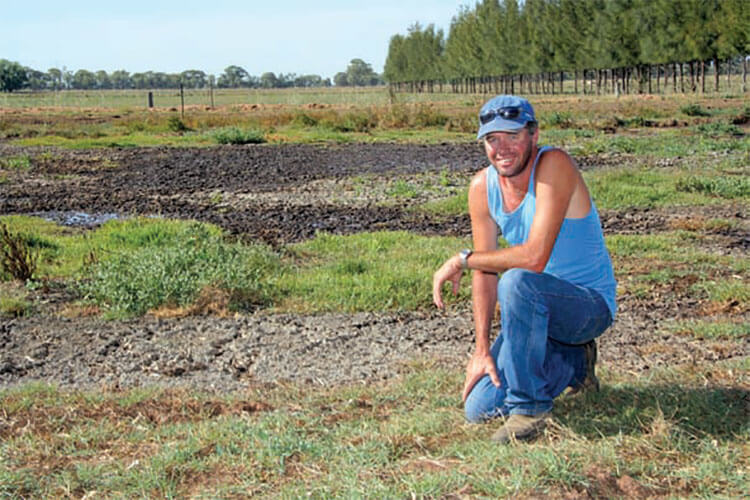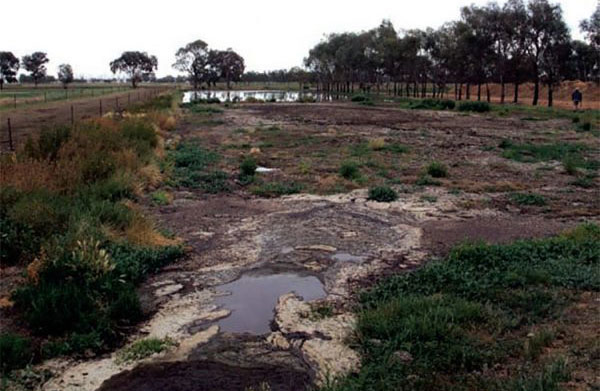
Case
Study
Location
Katunga, Victoria
Crop
Dairy
Maarten and Sharon van Tilborg, ‘Springtilly’ Katunga VIC
A Northern Victorian dairy farmer is gradually eliminating a football field-sized crust on his effluent pond by using a new ‘biologically active’ microbial culture.
Maarten and Sharon van Tilborg milk 610 Holstein, Jersey and crossbred cows, producing 4.5 million litres of milk a year at Katunga, 50 kilometres north of Shepparton. When they bought their property ‘Springtilly’ three years ago, after moving from New Zealand’s North Island, they found the 100 x 30 metre effluent pond to be in poor shape.
“Matters came to a head, so to speak, about two years ago when the pond began overflowing due to excessive rain.”
“The pond was more than big enough for the 50-bail rotary dairy, but it had a thick crust on top that covered most of the surface,” Maarten said. “It had a very strong odour that you could smell a couple of kilometres away on a windy day.
“We had the option of recycling the water from the pond into the flood wash but it stank, and even when we mixed the overflow with the irrigation water, what we were putting on the paddock had little nutrient value.”
Matters came to a head, so to speak, about two years ago when the pond began overflowing due to excessive rain. “The untreated overflow was running into the community drain and we were forced to empty the pond,” Maarten said.

Maarten van Tilborg with the effluent pond at ‘Springtilly’, Katunga, Victoria seven weeks after treatment. The dark patches show where the thick, dry crust is starting to break up due to increased microbial activity
“It cost us $6,500 for very little result – the crust was still there, the bottom of the pond was still full of solids, and it still stank.”
Last spring, Maarten agreed to participate in a trial using Digest-it® for Dairies, a fermented culture that helps to create and maintain a balanced microbial environment in effluent ponds. Developed by BioAg, Digest-it for Effluent provides a rich source of dormant aerobic bacteria and an additional food source for microbes, thereby stimulating microbial digestion of organic matter.
Depending on the thickness of the surface crust, a number of physical and chemical changes can be observed in ponds within four to six weeks of treatment. These include increased bubbling due to increased aerobic microbial activity and reduced surface crusting, turbidity, solids and odour.
In the longer term, nutrients that are otherwise ‘locked up’ in suspended solids are converted into a rich source of plant-available nutrients, reducing the need for de-sludging. The nutrients recovered reduce the need for fertiliser in the pasture.
Maarten activated the pond by applying 20 litres of Digest-it as a high-pressure spray to the crust-free end of the pond, in late October. Since then, he has poured 1.5 litres of the product onto the concrete apron before it is hosed down after each morning’s milking.
Not much appeared to happen for the first six weeks, but since then Maarten has been elated to see the crust starting to break down and the pond’s foul odour dissipating. “It took a while but in the last few weeks I’ve been surprised to see that it’s really working,” he said.

The pond before treatment with BioAg Digest-it for Dairies.
“It’s obviously been working really hard underneath the crust because a huge dark patch has appeared in the middle and it’s bubbling away around the edges as well as in the middle. “Now I’m noticing little cracks all over the place where the water is bubbling to the surface. There’s obvious activity across the whole pond.”
Maarten said the $3,500 annual cost of the microbial treatment would be more than offset by reduced costs associated with cleaning out the pond and excavating the sludge.
The van Tilborgs have since installed a secondary pond to further clean waste water before it is recycled through the flood wash system. “We’ll be milking 800 cows by winter but the combination of Digest-it and the second pond means our system will be much better able to cope with the increased load,” Maarten said.
“We’ll still have to empty the main pond occasionally, though this should be a lot less often than in the past. “It’s hard to say if we’d be saving money, but in the long run the environment will be better off and the water we recycle into the irrigation system will be a higher nutrient product, so we’ll be able to spend less on fertiliser.
“Environmental issues will catch up with Australian dairy farmers one day and I want to be ahead of the pack. I was born in Holland and was a dairy farmer in New Zealand for 20 years, so I’ve seen the effect of harsh environmental laws on agriculture. You need to start now if you want to stay ahead in the future.”
“Environmental issues will catch up with Australian dairy farmers one day and I want to be ahead of the pack. I was born in Holland and was a dairy farmer in New Zealand for 20 years, so I’ve seen the effect of harsh environmental laws on agriculture.”
Download case study
Download a PDF version of the above case study.

Recent Comments